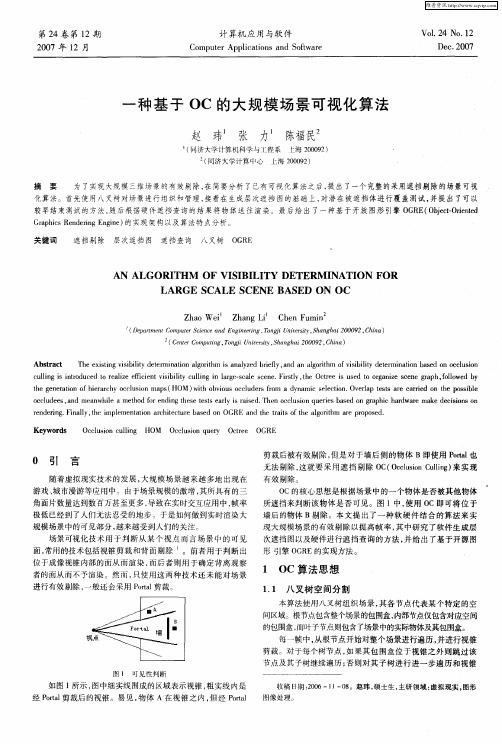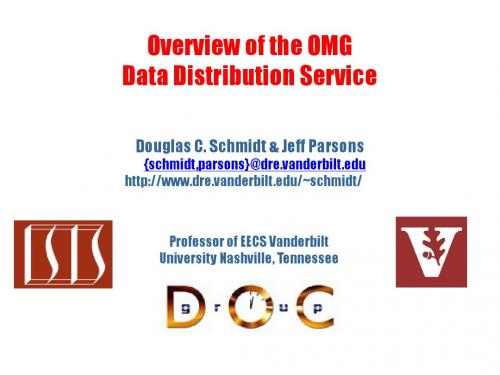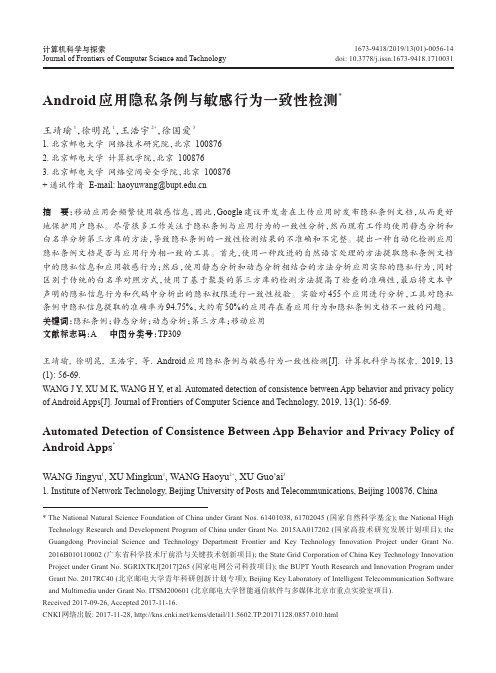A Survey of Visibility for Walkthrough Applications Daniel Cohen-Or1¢ 1Tel Aviv Universit
- 格式:pdf
- 大小:2.58 MB
- 文档页数:41



DMG19480C088_03WTC基于T5L ASIC 的8.88英寸1920×480像素点阵、16.7M 色、IPS 屏、电容触摸屏、标准指令集(TA )/DGUS Ⅱ系统、高性价比智能屏Based on T5L ASIC 8.88Inches,1920xRGBx480,16.7M Colors,IPS screen,CTP,Standard instruction set (TA)/DGUS Ⅱsystem修订记录Record of Revision日期/Revise Date 描述/Content 2019-12-25首次发布/First EditionCraft Data LimitedWebsite: ●参数Item数据Parameter说明Description 颜色Color16.7M(16777216)colors24bit color8R8G8B液晶类型Panel Type IPS IPS工艺TFT显示屏,俗称硬屏,具有对比度高、色彩还原好,视角宽(典型值是85/85/85/85)等特点。
High contras,good color reproduction,wide viewingangle(typical value is85/85/85/85)可视角度Viewing Angle85/85/85/85(Typ.)(CR≥10)最佳视角:上下左右对称Best View:symmetrical显示尺寸(A.A)218.88mm(W)×54.72mm(H)1920x480像素点阵1920x480Pixel视域尺寸(V.A)219.7mm(W)×55.5mm(H)1920x480像素点阵1920x480Pixel分辨率Resolution1920x480可以设置成0°/90°/180°/270°显示模式Support0°/90°/180°/270°rotated display背光模式Backlight LED 不低于20000H(以最高亮度连续工作,亮度减半时间)≥20000H(Continuous working with maximum brightness, time of the brightness decays to50%)亮度Brightness300nit TA模式:可进行64级亮度调节;DGUSⅡ模式:可进行100级亮度调节(当亮度调节至最高亮度的1%~30%时,可能出现闪烁现象,不建议在此范围使用)。

WEBs 应用手册关于霍尼韦尔霍尼韦尔是一家《财富》全球500 强的高科技企业。
我们的高科技解决方案涵盖航空、汽车、楼宇、住宅和工业控制技术,特性材料,以及物联网。
我们致力于将物理世界和数字世界深度融合,利用先进的云计算、数据分析和工业物联网技术解决最为棘手的经济和社会挑战。
在中国,霍尼韦尔长期以创新来推动增长,贯彻“东方服务于东方”和“东方服务于全球”的战略。
霍尼韦尔始创于1885 年,在华历史可以追溯到1935 年,在上海开设了第一个经销机构。
目前,霍尼韦尔四大业务集团均已落户中国,上海是霍尼韦尔亚太区总部,在华员工人数约11,000 人。
同时,霍尼韦尔在中国的30 多个城市拥有50 多家独资公司和合资企业,其中包括20 多家工厂,旨在共同打造万物互联、更智能、更安全和更可持续发展的世界。
欲了解更多公司信息,请访问霍尼韦尔中国网站www. ,或关注霍尼韦尔官方微博和官方微信。
霍尼韦尔霍尼韦尔智能建筑科技集团我们在全球拥有23,000 多名员工。
我们的产品、软件和技术已在全球超过1,000 万栋建筑中使用。
我们的技术确保商业楼宇业主和用户的设施安全、节能、具有可持续性与高生产力。
霍尼韦尔智能建筑科技集团深耕中国40 多年来,参与了30 多个城市的150 多条地铁的建设,为500 多座机场的智慧和安全保驾护航,为600 多家酒店提供智能管理系统,为1000多家医院提供了数字化解决方案。
目录第一部分 (4)霍尼韦尔智慧楼宇系统架构示意图 (4)霍尼韦尔智慧能源管理解决方案 (6)WEBs N4管理软件 (9)霍尼韦尔智慧触控屏 (13)第二部分 (17)系统控制器 WEB 8000 系列 (17)系统控制器 WEB 8000 VAV 专用系列 (21)边缘数据管理器 (24)增强型可编程通用控制器 (27)可编程通用控制器 (30)可编程通用控制器扩展模块 (33)BACnet 可编程通用 / VAV 控制器 (36)Lonworks 可编程通用 / VAV 控制器 (39)VAV 控制器 (43)BACnet 通用控制器 (46)Sylk TM I/O 扩展模块 (49)MVCweb 控制器 (52)UB系列独立控制器 (55)第三部分 (59)房间温控单元 (59)变风量末端墙装模块 (63)WTS3/6 系列温控器 (65)WTS8/9 系列温控器 (69)WS9 系列墙装模块 (73)建筑网络适配器 (76)智能电表 (78)4Ethernet / LANBACnet MS/TP Modbus RTU LonworksKNXSylk BusLightingModbus TCP BACnet IPBACnet IPAlarm Console clientWEB 8000 Web ControllerWEBStation Supervisor智慧触控屏Sylk I/O ModuleLonworks Spyder边缘数据管理器Spyder Universal ControllerPUC BACnet MS/TP Controller霍尼韦尔智慧楼宇系统架构示意图系统示意图仅用于显示设备在系统中的层次关系以及支持的通讯协议具体配置细节请结合实际项目情况,联系霍尼韦尔技术工程师进行架构设计5ElectricitySubmeterBACnet IPBACnet IPHTTPs , BACnet IP , oBIX , SNMP , …WEBs Enterprise Security WEBs Energy AnalyticsHAQ61增强型 BACnet IP ControllerFCU Wall ModuleVAV Controller EM Bus I/O ModuleSylk Bus Wall Module增强型 BACnet IP ControllerEM Bus6霍尼韦尔智慧能源管理解决方案智能高效,机器自学习功能准确分析,快速发现能耗异常功能全面,基于能耗大数据采集、趋势分析、评估诊断和流程控制的闭环管理功能数据准确,具有180多年计量仪表生产、安装与服务的专业知识灵活易用,云平台或本地部署灵活配置和迁移,操作简便扩展性好通过能源可见性、积极应对能耗异常和提高管理人员参与度,用户可以:★ 避免能耗异常波动★ 确保节能投资的投资回报率(ROI)符合预期★ 提高管理效率和降低运营成本研究显示,更多的企业为合规地实现节省成本、提高效率,越来越关注能源管理系统。


*The National Natural Science Foundation of China under Grant Nos.61401038,61702045(国家自然科学基金);the National High Technology Research and Development Program of China under Grant No.2015AA017202(国家高技术研究发展计划项目);the Guangdong Provincial Science and Technology Department Frontier and Key Technology Innovation Project under Grant No.2016B010110002(广东省科学技术厅前沿与关键技术创新项目);the State Grid Corporation of China Key Technology Innovation Project under Grant No.SGRIXTKJ[2017]265(国家电网公司科技项目);the BUPT Youth Research and Innovation Program under Grant No.2017RC40(北京邮电大学青年科研创新计划专项);Beijing Key Laboratory of Intelligent Telecommunication Software and Multimedia under Grant No.ITSM200601(北京邮电大学智能通信软件与多媒体北京市重点实验室项目).Received 2017-09-26,Accepted 2017-11-16.CNKI 网络出版:2017-11-28,/kcms/detail/11.5602.TP.20171128.0857.010.html计算机科学与探索Journal of Frontiers of Computer Science and TechnologyAndroid 应用隐私条例与敏感行为一致性检测*王靖瑜1,徐明昆1,王浩宇2+,徐国爱31.北京邮电大学网络技术研究院,北京1008762.北京邮电大学计算机学院,北京1008763.北京邮电大学网络空间安全学院,北京100876+通讯作者E-mail:haoyuwang@ 摘要:移动应用会频繁使用敏感信息,因此,Google 建议开发者在上传应用时发布隐私条例文档,从而更好地保护用户隐私。
旋轉式電阻抗斷層攝影系統之電極設計Designing of the Moving Electrodes in Rotary Electrical ImpedanceTomography System1徐鳳明2尤芳銘 1黃振寧1*鍾鴻源1Feng-Ming Hsu 2Fang-Ming Yu 1Cheng-Ning Huang 1Hung-Yuan Chung*1國立中央大學電機工程學系Department of Electrical Engineering, National Central University1* Corresponding authorE-mail: hychung@.tw2聖約翰科技大學資訊工程系Department of computer science and information Engineering,St. John’s University摘要阻抗影像的空間解析度(spatial resolution)和分辨率(distinguishability)是判斷EIT測量系統成像品質的重要指標,電阻抗斷層攝影系統中我們所採用的系統架構、電流驅動模式、定電流源的穩定度與重建演算法皆會影響阻抗成像的品質。
利用旋轉式電極的概念,我們可以增加邊界電壓的獨立資料量數倍,使得影像解析度不佳的問題獲得大幅的改善。
然而,EIT測量系統易受雜訊干擾與金屬電極氧化的影響,引起邊界電壓資料精確度不佳、可靠性低,導致成像失敗,而影響系統精確度不佳的主要原因為與待測區域接觸的感測電極。
本文將提出新型的複合式電極結構,可有效增加電壓電極之間的間距與電流電極的接觸面積,提高訊號雜訊比(SNR),與成像分辨率,由實驗獲得的成像結果可以驗證,旋轉式電阻抗斷層攝影系統的精確度已獲得更進ㄧ步的改善。
關鍵字: 旋轉式電阻抗斷層攝影系統、空間解析度、分辨率、複合式電極結構AbstractSpatial resolution and distinguishability is an important index to estimate the image quality of electrical impedance tomography system. The factors affecting the quality of EIT image include the system structure, the constant current source, the reconstructor algorithm, and current driven pattern. By Utilizing the rotary electrode, REIT can increase the boundary voltage and make the spatial resolution of the impedance image better. However, The accuracy of the measurement data is easily influenced by the noise and the oxidization of the metal electrode. These noises lead to failure of the image reconstruction. Because the main reason for impairing the system accuracy is caused by the structure of the electrode array. In this paper we will propose a new composed-electrode structure. Increasing the interval between voltage-collection electrodes and expanding the area of the current-driven electrodes can improve the signal-to-noise ratio and the distinguishability effectively. According to the experimental results, the image quality of REIT become much better.Keywords: rotary electrical impedance tomography (REIT), spatial resolution, distinguishability ,composed-electrode structure1.EIT簡介 (Introduction)1976年美國Wisconsin Madison大學的Swanson教授首先提出胸剖面(frontal plane)阻抗成像技術,因而引起各國學者的廣泛興趣,開始著手研究人體的電阻抗成像,作為醫學診斷的輔助工具。
ASurveyofVisibilityforWalkthroughApplicationsDanielCohen-Or1YiorgosChrysanthou2†Cl´audioT.Silva3‡1TelAvivUniversity2UniversityCollegeLondon3AT&TLabs-Research
AbstractThelastfewyearshavewitnessedtremendousgrowthinthecomplexityofcomputergraphicsmodelsaswellasnetwork-basedcomputing.Althoughsignificantprogresshasbeenmadeinthehandlingofspecifictypesoflargepolygonaldatasets(i.e.,architecturalmodels)onsinglegraphicsworkstations,onlyrecentlyhaveresearchersstartedtoturntheirattentiontomoregeneralsolutions,whichnowincludenetwork-basedgraphicsandvirtualenvironments.Thesituationislikelytoworseninthefuturesince,duetotechnologiessuchas3Dscanning,graphicalmodelsarebecomingincreasinglycomplex.Oneofthemosteffectivewaysofmanagingthecomplexityofvirtualenvironmentsisthroughtheapplicationofsmartvisibilitymethods.Visibilitydetermination,theprocessofdecidingwhatsurfacescanbeseenfromacertainpoint,isoneofthefundamentalproblemsincomputergraphics.Itisrequirednotonlyforthecorrectdisplayofimagesbutalsoforsuchdiverseapplicationsasshadowdetermination,globalillumination,cullingandinteractivewalkthrough.Theimportanceofvisibilityhaslongbeenrecognized,andmuchresearchhasbeendoneinthisareainthelastthreedecades.Theproliferationofsolutions,however,hasmadeitdifficultforthenon-experttodealwiththiseffectively.Meanwhile,innetwork-basedgraphicsandvirtualenvironments,visibilityhasbecomeacriticalissue,presentingnewproblemsthatneedtobeaddressed.Inthissurveywereviewthefundamentalissuesinvisibilityandconductanoverviewoftheworkperformedinrecentyears.
1IntroductionThetermvisibilityisverybroadandhasmanymeaningsandapplicationsinvariousfieldsofcomputerscience.Here,wefocusonvisibilityalgorithmsinsupportofvirtualrealityapplications.Foramoregeneralsurveysee[23](alsoappearsin[14]).Forthoseinterestedinthecomputationalgeometryliterature,see[21,20,22].Zhang’sthesis[80]containsashortsurveyofcomputergraphicsvisibilitywork.MollerandHaines[50,Chapter7]coverseveralaspectsofvisibilityculling.(a)(b)Figure1:Withindoorscenesoftenonlyaverysmallpartofthegeometryisvisiblefromanygivenview-point.CourtesyofCraigGotsman,Technion.
Wedealprimarilywithalgorithmsrelatedtowalkthroughapplicationswhereweassumethatasceneconsistsofaverylargenumberofprimitives.Moreover,weassumethatmodelskeepgettinglargerandmorecomplexandthatuserappetitewillneverbesatisfiedwiththecomputationalpoweravailable.Forverycomplexmodelswecanusuallydobetterwithasmartrenderingalgorithmthanwithfastermachines.Oneofthemostinterestingvisibilityproblemsinthiscontextistheoneofselectingasetofpolygonsfromthemodelthatisvisiblefromagivenviewpoint.Moreformally(after[21]),letthescene,,becomposedofmodelingprimitives(e.g.,triangles)01...,n,andaviewingfrustumdefininganeyeposition,aviewdirection,andafieldofview.Thevisibilityproblemencompassesfindingthevisiblefragmentswithinthescene,thatis,connectedtotheeyepointbyalinesegmentthatmeetstheclosureofnootherprimitive.Oneoftheobstaclestosolvingthevisibilityproblemisitscomplexity.ForascenewithnOprimitives,thecomplexityofthesetofvisiblefragmentsmightbeashighasOn2(i.e.,quadraticinthenumberofprimitivesintheinput).Whatmakesvisibilityaninterestingproblemisthatforlargescenes,thenumberofvisiblefragmentsisusuallymuchsmallerthanthetotalsizeoftheinput.Forexample,inatypicalurbanscenes,onecanseeonlyaverysmallportionoftheentiremodel,regardlessofone’slocation.Suchscenesaresaidtobedenselyoccluded,inthesensethatfromanygivenviewpoint,onlyasmallfractionofthesceneisvisible[15].Otherexamplesincludeindoorscenes,wherethewallsofaroomoccludemostofthescene,andinfact,fromanyviewpointinsidetheroom,onemayonlyseethedetailsofthatroomorthosevisiblethroughtheportals,seeFigure1.Adifferentexampleisacopyingmachine,showninFigure2,wherefromtheoutsideonecanonlyseeitsexternalparts.Althoughintuitive,thisinformationisnotavailableaspartofthemodelrepresentation,andonlyanon-trivialalgorithmcandetermineitautomatically.Notethatoneofitsdoorsmightbeopen.Visibilityisnotaneasyproblem,sinceasmallchangeintheviewpointmightcauselargechangesinthevisibility.Itmeansthatsolvingtheproblematonepointdoesnothelpmuchinsolvingitatanearbypoint.
2(a)(b)
Figure2:Acopyingmachine;onlyafractionofthegeometryisvisiblefromtheoutside.CourtesyofCraigGotsman,Technion.
(a)(b)Figure3:Asmallchangeintheviewingpositioncancauselargechangesinthevisibility.
3